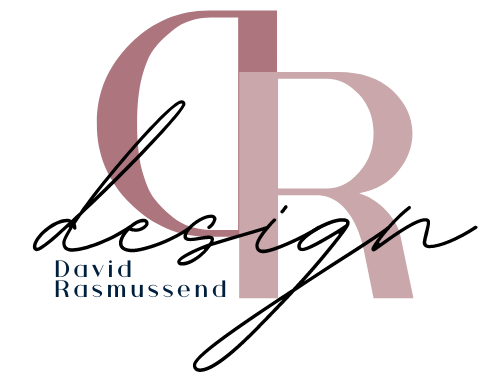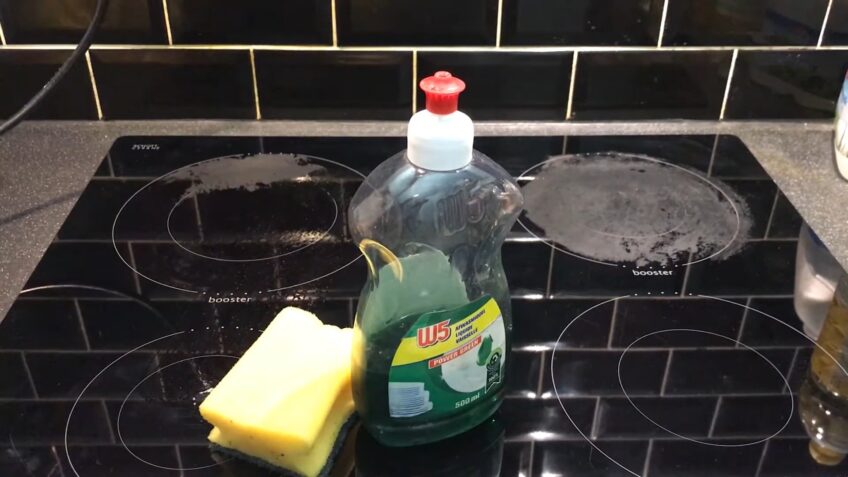A sleek glass stove top is a stylish addition to any modern kitchen. However, with everyday cooking, it’s not uncommon for burn marks and stains to compromise its pristine look.
But worry not, restoring your glass stove top’s shine is achievable with a few household items and a bit of elbow grease.
The Basics
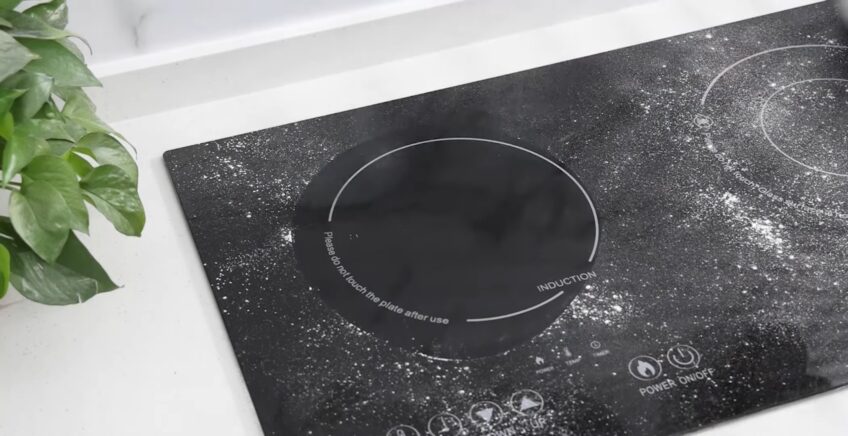
Before diving into cleaning methods, it’s essential to understand the material you’re working with to ensure safety and effectiveness.
Composition of Glass Stove Tops
Glass stove tops, despite their name, are not made of typical glass. Instead, they consist of a robust and heat-resistant material called ceramic glass. This unique composition allows it to withstand high temperatures, making it ideal for cooking.
Why Burn Marks Appear
Burn marks on glass tops primarily result from spills, especially from sugary or starchy foods that can caramelize when subjected to heat. The longer these spills sit and get exposed to heat, the more stubborn the resulting burn marks become.
Prevention: The First Line of Defense

Taking proactive steps to prevent burns is equally as vital as knowing how to remove them.
Proper Cookware Selection
Flat-Bottomed Pans: These ensure even heating and reduce the risk of spills.
Right Size: Using a pan that matches the burner size can prevent drips and spills.
Timely Cleanup
Addressing spills immediately after they happen (once it has cooled down) can prevent them from becoming hard-to-remove burn marks later. A simple wipe with a damp cloth can go a long way.
Natural Cleaning Solutions
Harness the power of everyday household items to tackle those stubborn burn marks without the use of harsh chemicals.
Baking Soda and Water
A mixture of baking soda and water can work wonders:
- Step 1: Sprinkle baking soda over the burn mark.
- Step 2: Dampen a cloth with water and gently scrub the area in a circular motion.
White Vinegar
This kitchen staple is not only great for cooking but also for cleaning:
- Step 1: Spray or dab white vinegar on the burn mark.
- Step 2: Let it sit for a few minutes before wiping away with a soft cloth.
Commercial Cleaning Solutions
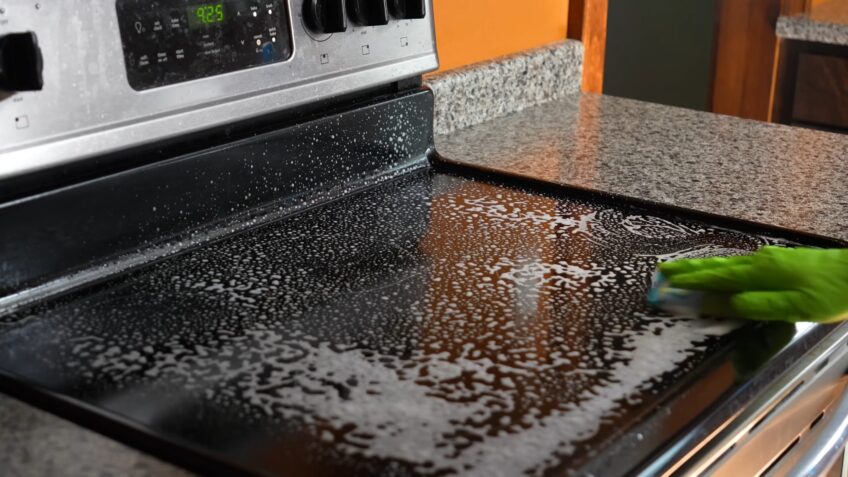
While natural methods work wonders, there are occasions when commercial cleaning agents might be more effective for particularly stubborn marks.
Glass Stove Top Cleaners
Several brands offer specialized cleaners formulated explicitly for glass stove tops. These products usually come with:
- Scrubbing Pads: Ensure they’re non-abrasive to avoid scratches.
- Creamy Consistency: This helps in gentle yet effective scrubbing.
Using Razor Blades
Yes, a razor can be a handy tool:
- Step 1: Hold the razor blade at a 45-degree angle.
- Step 2: Gently scrape the burn mark. It’s crucial to be gentle to avoid scratches.
Post-Cleaning Maintenance
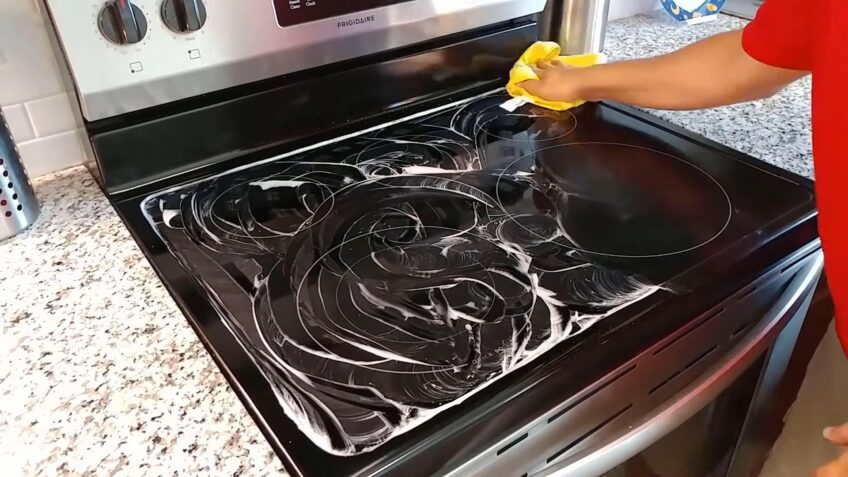
Once you’ve successfully removed the burn marks, maintaining that clean shine is the next challenge.
Regular Wiping
Daily Routine: Develop a habit of wiping down your stove after every use, once it has cooled.
Microfiber Cloths: These are excellent for cleaning without leaving lint or scratches behind.
Avoid Abrasives
Never use abrasive cleaning pads or harsh chemicals, as these can leave permanent scratches or damage the top’s protective finish.
Safety Precautions
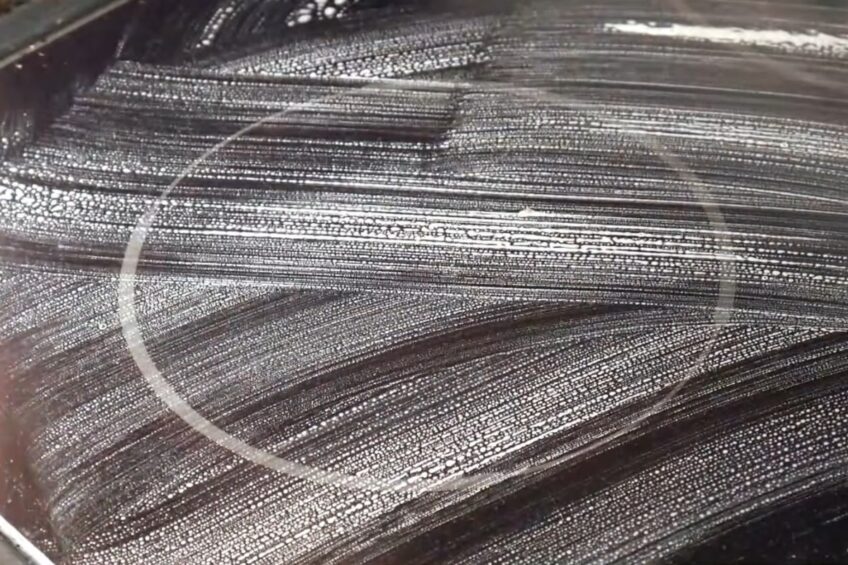
Cleaning involves certain risks, especially when dealing with a combination of electricity and liquids. Safety should always come first.
Disconnecting Power
Always ensure the stove is switched off, and preferably unplugged, when undertaking any deep cleaning. This prevents any chance of electrical mishaps.
Avoiding Overly Wet Cloths
Never use a dripping wet cloth on the top. Excess water can seep into the mechanisms, causing electrical issues or even posing a fire risk.
Common Mistakes to Avoid
Your stove is a significant investment, and incorrect cleaning methods can reduce its lifespan. Here’s what you should steer clear of:
Using Harsh Scrubbing Pads
Abrasive materials can easily scratch your glass stove top, making it look worn out. Always opt for soft cloths or pads specifically designed for glass surfaces.
Applying Cleaning Solutions Directly
Pouring a cleaning agent directly onto the stove can lead to it seeping into the burners, potentially causing damage. Always apply the solution to a cloth first.
Burn Marks vs. Scratches
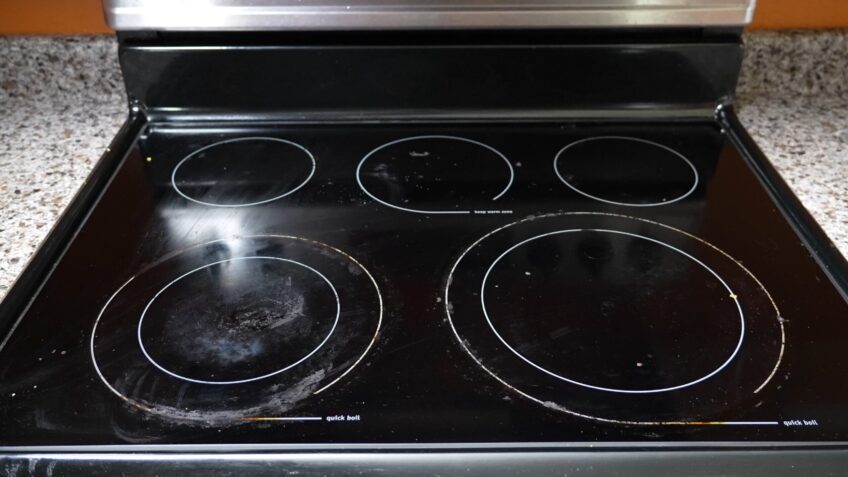
Not every mark on your stove is a burn mark. Some might be scratches, which require a different approach.
Identifying Scratches
Scratches may appear as thin lines or grooves on the stove top. Unlike burn marks, they cannot be scrubbed away as they are physical damages to the glass surface.
Dealing with Scratches
For minor scratches, specialized scratch removal kits are available. However, deep scratches might be permanent and may require professional assessment.
Maximizing Your Stove’s Lifespan
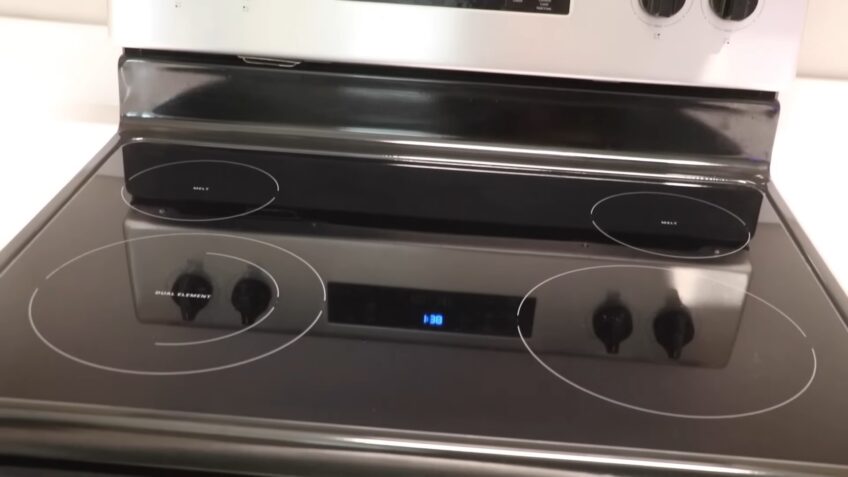
Your stove’s longevity isn’t just about cleaning; it’s about holistic care.
Using Proper Cookware
Weight: Heavy pots can cause unnecessary strain or even lead to cracks.
Material: Some materials can leave residues; consult the manual for recommended cookware.
Being Gentle
Avoid dropping cookware or using it as a makeshift counter. These practices can lead to scratches, cracks, or other damages.
DIY vs. Professional Cleaning
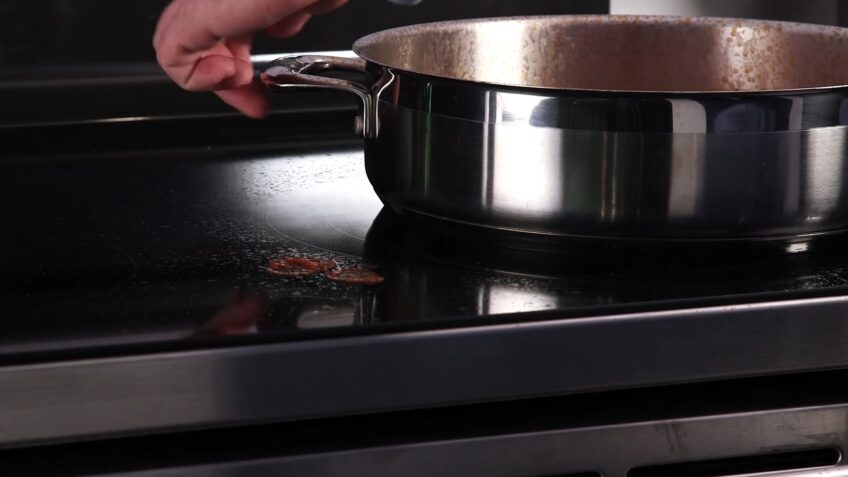
While DIY methods are efficient for regular maintenance and minor burns, there are times when professional help is beneficial.
When to Consider Professional Cleaning
If you’ve tried multiple methods and the stubborn marks persist, it might be time to consider a professional service. Additionally, deep scratches or potential internal damage due to spills will require expert intervention.
Benefits of Professional Cleaning
- Thoroughness: Professionals have specialized equipment and solutions.
- Safety: They ensure the cleaning process won’t lead to further damage or risk.
Eco-friendly Cleaning Alternatives
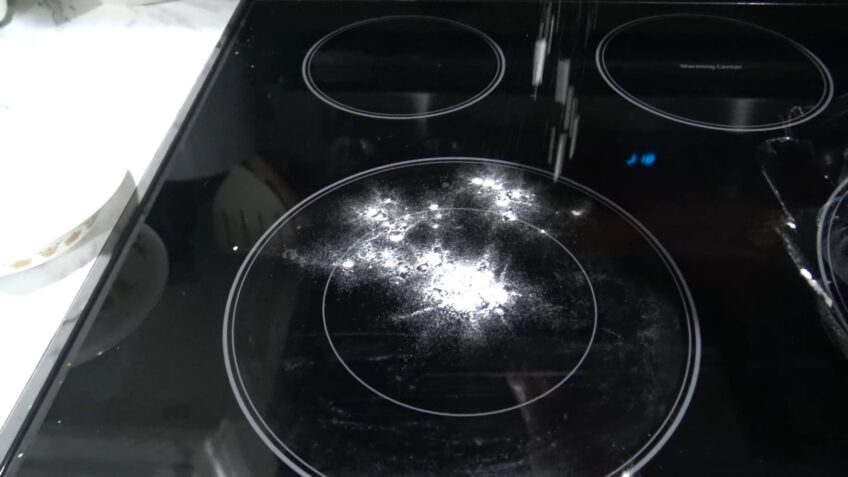
In an era of sustainable living, opting for green solutions is not only good for your stove but also the planet.
Lemon and Baking Soda
Lemon’s natural acidity combined with baking soda’s abrasive nature can tackle stains efficiently:
- Step 1: Sprinkle baking soda over the burn mark.
- Step 2: Rub a lemon half over the stain in a circular motion.
Olive Oil and Baking Soda
Olive oil acts as a lubricant, reducing scratches while baking soda addresses the burn:
- Step 1: Create a paste with equal parts.
- Step 2: Apply to the mark, wait 10 minutes, then wipe off.
Future-Proofing Your Stove Top

A little foresight can save a lot of effort in maintaining your stove top’s pristine look.
Invest in Protective Covers
There are silicone covers available that protect your stove from spills and minor drops, without affecting the cooking process.
Upgrade to Scratch-Resistant Models
If you’re in the market for a new stove, consider models that offer scratch-resistant surfaces or advanced coatings for easier cleaning.
FAQs
How often should I clean my glass stove top?
It’s recommended to wipe down your stove top after every use once it has cooled. For deeper cleans or to remove burn marks, once a week or bi-weekly should suffice, depending on usage.
Can I use regular dish soap for cleaning?
Yes, mild dish soap can be effective for routine cleaning. However, for tougher burn marks, specialized cleaning methods or products might be more effective.
Are there risks to using a razor blade on my glass stove top?
If used correctly, a razor blade can be a useful tool. Ensure it’s held at a 45-degree angle and applied gently to avoid scratching the surface.
I’ve heard vinegar is a good cleaning agent. Can I use it on my stove top?
A solution of white vinegar and water can be an effective, eco-friendly cleaning agent for glass stove tops.
I can’t differentiate between a burn mark and a scratch. How do I know the difference?
Burn marks are usually brown or black spots that sit on the surface, while scratches may appear as thin lines or grooves on the top and can be felt if you run your finger over them.
Are commercial cleaning products safe for my stove and the environment?
Most commercial products designed for glass stove tops are safe when used as directed. However, if environmental impact is a concern, always check the product label for eco-friendly certifications or opt for natural cleaning methods.
Can burn marks damage my stove’s functionality over time?
While occasional burn marks won’t harm your stove’s function, consistent neglect can lead
Summary
Maintaining a clean and spotless glass top not only ensures a polished aesthetic for your kitchen but also promotes safety and functionality. From tried-and-true home remedies to specialized commercial solutions, the path to a gleaming top is diverse.
By understanding the different challenges – be it burn marks, scratches, or daily dirt – and armed with the right techniques, you can ensure that your stove remains a centerpiece of pride in your kitchen.
